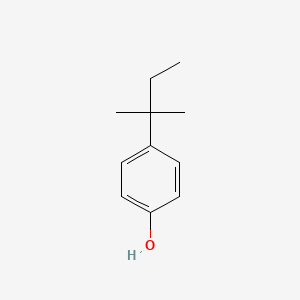D0709 | 4-(2-methylbutan-2-yl)phenol
| Toxicity | Dose | Time | Species | Model | Method | Action | Positive criterion | Reference |
|---|---|---|---|---|---|---|---|---|
| MEMBRANE POTENTIAL | 22.71±3.07 | human | qHTS-HepG2 | MMP assay | decrease | IC50 | 163 | |
| MEMBRANE POTENTIAL | 35.48 | human | HepG2 | MMP assay | decrease | IC50 | 163 | |
| MEMBRANE POTENTIAL | rat | hepatocytes | MMP assay | Negative | IC50 | 163 | ||
| Pictogram | Signal | Statements | Precautionary Statement Codes |
|---|---|---|---|
   |
Danger |
Aggregated GHS information provided by 230 companies from 14 notifications to the ECHA C&L Inventory. Each notification may be associated with multiple companies. Reported as not meeting GHS hazard criteria by 5 of 230 companies. For more detailed information, please visit ECHA C&L website Of the 13 notification(s) provided by 225 of 230 companies with hazard statement code(s): H302 (49.78%): Harmful if swallowed [Warning Acute toxicity, oral] H312 (41.33%): Harmful in contact with skin [Warning Acute toxicity, dermal] H314 (98.67%): Causes severe skin burns and eye damage [Danger Skin corrosion/irritation] H317 (36.44%): May cause an allergic skin reaction [Warning Sensitization, Skin] H318 (50.22%): Causes serious eye damage [Danger Serious eye damage/eye irritation] H410 (12.44%): Very toxic to aquatic life with long lasting effects [Warning Hazardous to the aquatic environment, long-term hazard] H411 (56.89%): Toxic to aquatic life with long lasting effects [Hazardous to the aquatic environment, long-term hazard] Information may vary between notifications depending on impurities, additives, and other factors. The percentage value in parenthesis indicates the notified classification ratio from companies that provide hazard codes. Only hazard codes with percentage values above 10% are shown. |
P260, P261, P264, P270, P272, P273, P280, P301+P312, P301+P330+P331, P302+P352, P303+P361+P353, P304+P340, P305+P351+P338, P310, P312, P321, P322, P330, P333+P313, P363, P391, P405, and P501; (The corresponding statement to each P-code can be found at the GHS Classification page.) |
    |
Danger |
H312: Harmful in contact with skin [Warning Acute toxicity, dermal] H314: Causes severe skin burns and eye damage [Danger Skin corrosion/irritation] H318: Causes serious eye damage [Danger Serious eye damage/eye irritation] H335: May cause respiratory irritation [Warning Specific target organ toxicity, single exposure Respiratory tract irritation] H361: Suspected of damaging fertility or the unborn child [Warning Reproductive toxicity] H370: Causes damage to organs [Danger Specific target organ toxicity, single exposure] H401: Toxic to aquatic life [Hazardous to the aquatic environment, acute hazard] H410: Very toxic to aquatic life with long lasting effects [Warning Hazardous to the aquatic environment, long-term hazard] |
P201, P202, P260, P261, P264, P270, P271, P273, P280, P281, P301+P330+P331, P302+P352, P303+P361+P353, P304+P340, P305+P351+P338, P307+P311, P308+P313, P310, P312, P321, P322, P363, P391, P403+P233, P405, and P501; (The corresponding statement to each P-code can be found at the GHS Classification page.) |
| Organism | Test type | Route | Dose (normalized dose) | Effect | Source |
|---|---|---|---|---|---|
| rabbit | LD50 | skin | 2gm/kg (2000mg/kg) | Union Carbide Data Sheet. Vol. 8/13/1964, | |
| rat | LD50 | oral | 1830mg/kg (1830mg/kg) | Industrial Hygiene Foundation of America, Chemical and Toxicological Series, Bulletin. Vol. 6, Pg. 1, 1967. | |
| 1-Hydroxy-4-(1,1-dimethylpropyl)benzene | 1-Hydroxy-4-(2-methyl-2-butyl)benzene | 2-Methyl-2-p-hydroxyphenylbutane |
| 4 - (1,1 - Dimethylpropyl) phenol | 4-(1,1-DIMETHYLPROPYL)PHENOL | 4-(1,1-Dimethyl-propyl)-phenol |
| 4-(1,1-Dimethylpropyl)-1-phenol | 4-(2-methylbutan-2-yl)phenol | 4-(tert-pentyl)phenol |
| 4-06-00-03383 (Beilstein Handbook Reference) | 4-t-Amylphenol | 4-t-pentylphenol |
| 4-tert-Amylphenol | 4-tert-Amylphenol, 99% | 4-tert-Amylphenol, analytical standard |
| 4-tert-Pentylphenol | 6NP9LYK846 | 80-46-6 |
| A0460 | A24574 | AC-16506 |
| ACMC-1BMFO | AI3-00460 | AKOS000119604 |
| AM20041188 | ANW-37372 | Amilfenol |
| Amilphenol | Amyl phenol 4T | BDBM50410536 |
| BIDD:ER0210 | BRN 1908224 | C14226 |
| CAS-80-46-6 | CCRIS 4693 | CHEBI:35096 |
| CHEMBL195693 | CTK3J2800 | Caswell No. 050 |
| DB-000247 | DSSTox_CID_1771 | DSSTox_GSID_21771 |
| DSSTox_RID_76317 | DTXSID8021771 | EC 201-280-9 |
| EINECS 201-280-9 | EPA Pesticide Chemical Code 064101 | FT-0704191 |
| HMS3039M10 | HSDB 5236 | InChI=1/C11H16O/c1-4-11(2,3)9-5-7-10(12)8-6-9/h5-8,12H,4H2,1-3H3; |
| KS-00000JPD | KSC492Q0B | L777 |
| LS-1796 | M-5973 | MCULE-4223490735 |
| MFCD00002369 | MLS002152935 | NCGC00091655-01 |
| NCGC00091655-02 | NCGC00091655-03 | NCGC00091655-04 |
| NCGC00091655-05 | NCGC00254041-01 | NCGC00259900-01 |
| NRZWYNLTFLDQQX-UHFFFAOYSA- | NRZWYNLTFLDQQX-UHFFFAOYSA-N | NSC 403672 |
| NSC-403672 | NSC-4965 | NSC403672 |
| NSC4965 | Nipacide PTAP | P-(1,1-Dimethylpropyl)phenoL;Para-tert-amylphenol |
| Para-tertiary amylphenol | Pentaphen | Pentaphen 67 |
| Phenol, 4-(1,1-dimethylpropyl)- | Phenol, p-(tert-pentyl)- | Phenol, p-tert-pentyl- |
| Phenol,1-dimethylpropyl)- | Ptap | Q26840951 |
| RTR-030897 | SBB056682 | SC-16181 |
| SCHEMBL49704 | SMR001224530 | ST081338 |
| ST24023648 | TR-030897 | Tox21_111159 |
| Tox21_111159_1 | Tox21_202351 | Tox21_300088 |
| UNII-6NP9LYK846 | Ucar amyl phenol 4T | W-109280 |
| WLN: QR D1X1&1&1 | Z1262246132 | ZINC1680640 |
| p-(.alpha.,.alpha.-Dimethylpropyl)phenol | p-(1,1-Dimethyl propyl) phenol | p-(1,1-Dimethylpropyl)phenol |
| p-(alpha,alpha-Dimethylpropyl)phenol | p-(tert-Amyl)phenol | p-t-Amyl phenol |
| p-t-Pentylphenol | p-t-amylphenol | p-tert-Amylphenol |
| p-tert-Pentylphenol | p-tertamylphenol | para-tert-Amylphenol |
| tert-Amylphenol |

